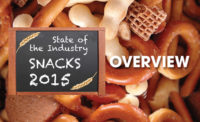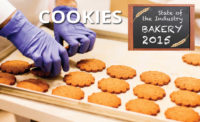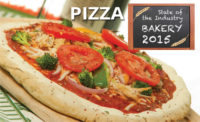Cracker market requires flexibility: State of the Industry 2015


courtesy of 34 Degrees


courtesy of WP Bakery Group USA

courtesy of Baker Perkins











As Americans increasingly replace proper meals with snacking, convenience becomes a central purchase motivator at retail. What can be eaten on the go? What is nutritious enough to replace a traditional meal? What tastes great within an intriguing product format?
Overview | Chips | Puffed/Extruded Snacks | Popcorn | Snack Mixes & Nuts | Tortilla Chips | Pretzels | Frozen Snacks | Crackers
For many years, the answer to these questions was not crackers. Crackers were meal sidekicks, not stars. They needed spreads and soups to deliver the taste and satiety a meal or hearty standalone snack.
But that was then, and now cracker manufacturers have begun to build flavor profiles and product formats that help crackers stand alone as snack stars.
Market data
Today’s crackers compete on convenience by offering knockout flavors, and sometimes with better-for-you label appeal. While data from IRI, Chicago, reveals overall category sales have been generally flat—clocking in at roughly $7.2 billion in the 52 weeks ending May 17, 2015—this isn’t the whole story. Sales of options like breadsticks (down 7.5 percent) and saltines (down 2 percent)—which don’t stand well as a snack on their own—took a hit as shoppers opted for one-stop cracker options that deliver on taste and nutrition. And they’re buying them in droves.
Mondeléz saw a good sales bump for the period, with its Nabisco Ritz crackers with fillings up 46.28 percent in dollar sales, per IRI. Elsewhere in filled crackers, Frito-Lay’s Munchies brand was up 9.98 percent in dollar sales. Pepperidge Farm brand Goldfish crackers continue to perform well, up 5.67 percent in dollar sales, accounting for $476.7 million. Over in graham crackers, two standout brands were Kellogg Co. Keebler Scooby Doo brand, which saw a gain of 12.97 percent dollar share, and Mondeléz Nabisco Honey Maid graham crackers, up 9.19 percent, per IRI.
And select demographics are more cracker-centric than others. A January 2014 report by Packaged Facts, “Crackers: U.S. Market Trends,” showed that while the total number of households using crackers increased only slightly between 2004 and 2013, the percentage of households purchasing 12 or more bags grew by nearly 18 percent during this period. It was these households that accounted for nearly 90 percent of growth in consumption of crackers during that period.
Clearly, the devotee is in the driver’s seat.
Looking back
In today’s market, convenience isn’t enough. Consumers also demand a healthier nutritional profile for the foods they buy, and in the crackers market, the story is no different. A 2013 report released by Innova Market Insights found that 80 percent of the launches of savory crackers in the U.S. are based on a health platform. And when crackers can deliver on health, they make for a guilt-free option that can win out with shoppers over other savory snacks on the market.
“Grazing and health are particularly important at the moment, and snack crackers play into both of these categories,” says Keith Graham, marketing manager, Baker Perkins, Peterborough, England. “They are inherently healthier than many other snacks because they are baked, not fried. They can be packaged for consumption on the go, and they provide a tasty and satisfying snack or meal component.”
Indeed, not only are many crackers often devoid of “harmful” ingredients (like trans fats, etc.), but some products boast ingredients that make a positive contribution to health, Graham says, such as whole grains, ancient grains, fiber and protein.
According to the Packaged Facts “Crackers: U.S. Market Trends” report, more consumers are reaching for crackers instead of salty snack mainstays like chips and pretzels because they offer the same convenience and fewer nutritional downfalls. As a result, the report says, one of the biggest market drivers going forward will be brands’ ability to connect crackers with health and wellness via better ingredients or good-for-you packaging—two avenues chips, for example, can’t quite traverse.
Looking ahead
To compete with chips and pretzels, crackers must stand on their own when it comes to flavor. And if it’s convenience they’re courting, cracker brands need to deliver on flavor expectations—with or without added components like fillings and topical ingredients.
“The current cracker snack wave has already inspired new flavor innovations, and it’s also driving the industry to offer healthier options with more artisanal ingredients,” says Craig Lieberman, founder and president, 34 Degrees, Denver. To that end, the company recently launched two new flavors of 34 Degrees Crisps: Toasted Onion and Poppy Seed. “Toasted Onion’s rich flavor makes it very snackable,” he says. However, he suggests the product also partners well with aged cheese, cured meats, pesto, olive tapenade and other cracker companions. This variety joins the current line of Natural, Sesame, Cracked Pepper, Rosemary and Whole Grain.
Select cracker brands are growing in popularity because of their convenience factor, but many consumers haven’t forgotten crackers’ roots as supporting acts to spreads, dips, cheeses, meats and other toppings. According to Lieberman, this holds the key to yet another way cracker brands can capitalize on shifting meal trends in America: appealing to consumer desire for a variety of mini meals throughout the day, as opposed to three traditional meals. “We see a ton of opportunity to create mini meals with crackers and fresh toppings,” he says. The brand’s packaging plays into this trend by offering imagery of pairing ideas.
Graham sees the crackers market as one that’s ultimately split in two. On the one side are traditional crackers sold in boxes and distributed through grocery channels. On the other side are snack crackers, “which tend to be smaller, packaged for convenience, on-the-go eating, and intensively distributed,” he says, in retail channels like grocery stores, gas stations, convenience stores and vending machines.
If the latter is where the cracker market is headed, though, manufacturers with older technology designed for one variety of cracker may struggle to keep up. “The snacks category is innovation-hungry, so one successful new product needs to be followed up by another with different ingredients, more healthy or indulgent varieties, different flavors and different formats—for example, filled crackers,” Graham says. “This is the sort of progression that consumers are used to and expect in snacks, but it can cause problems for manufacturers whose production lines are dedicated to traditional cracker technology.” Today’s cracker market calls for equipment flexibility.
Graham predicts a gradual shift away from dedicated lines to a more-flexible process that can produce not just crackers, but also a wider range of nontraditional snacks. One approach involves using a twin-screw extruder and sheeting die to create sheets of dough ready for cutting. “Not only is this much smaller and more cost-effective than a traditional cracker line, but it is infinitely more flexible,” he says. “With a few simple changes, it can move from making snack crackers to extruded or co-extruded snacks in a few minutes.”
Manufacturers can often integrate new production technologies into existing cracker lines, suggests Patricia Kennedy, president, WP Bakery Group USA, Shelton, CT. New machines have the flexibility to produce “classic, filled or twisted snacks,” she notes.
“Industry innovators will continue to breathe new life and exciting shifts in how people perceive the humble cracker,” says Lieberman. “Additionally, we believe the delineation between crackers, crisps and chips will continue to blend as crackers take more of a stronghold in the snack category.”
Overview | Chips | Puffed/Extruded Snacks | Popcorn | Snack Mixes & Nuts | Tortilla Chips | Pretzels | Frozen Snacks | Crackers
Looking for a reprint of this article?
From high-res PDFs to custom plaques, order your copy today!













